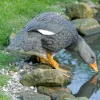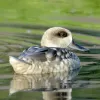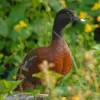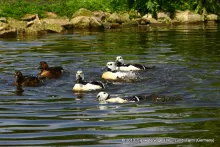
Steller's eider (Polysticta stelleri)
Species name
- Dutch name:
- Stellers eider
- English name:
- Steller's eider
- German name:
- Scheckente
- French name:
- Eider de Steller
- Scientific name:
- Polysticta stelleri
Scientific classification
- Order:
- Anseriformes
- Family:
- Anatidae
- Onderfamilie:
- Merginae
- Genus:
- Polysticta
Description
- Description:
Male:
White Head and neck, with black chin, throat and patch around eye; greenish on lores and forming tufts each side of hind crown, stemming from black spots. Collar (a bluish teal iridescence in color) Black, narrower at front, joining with black on mantle and extending down center of upperparts to long and pointed tail. Breast, belly and flanks warm chestnut-buff, darker on center of breast and belly , paler on flanks and becoming white towards wings, with round black spot at sides of breast; vent and undertail converts black. Sides of mantle and back white; scapulars and tertails elongated and pointed, black (tinged purplish blue) with broad white edges, drooping over a closed wing. In flight, forewing white, speculum iridescent purplish blue boarderd behind by broad white tips, and primaries blackish; underwing mainly white, with grey flight feathers. Bill, legs and feet blue-grey
Eclipse Dark reddish-brown all-over, but with upperwing converts retained and head and breast with white mottlingFemale:
Dark reddish-brown all-over. Indistinct pale buffish eye-ring and slightly paler on cheeks. Obscurely mottled black on upperparts. tertails elongated and sickle shaped, grayish-blue on outer webs, brown on inner. , speculum iridescent purplish blue boarderd behind by broad white tips but confined to innermost secondaries , reminder dull brown , and with white bar in front as well behind, while forewing dark red brown ; underwing mainly white, with grey flight feathers. But greyer on converts. Bill , legs and feet blue-greyJuvenile:
As female but duller Brown, without reddish tone , and more clearly marked darker on underparts. Speculum almost lacks blue, with white boarders narrow or even absent . Males start to acquire adult plumage first year. But don’t fully plumed as a adult until 2nd Winter.
- Behaviour:
Only the female incubates. She remains on the nest, taking a few short breaks (under an hour) each day to feed. Males may remain near the nest during early incubation, but in general they become decreasingly associated with nest sites and females after the onset of incubation.
Standard Measurements
- Body Length (cm):
- The male (drake) of the Steller's eider measures approximately 43-46 centimeters. The female measures approximately 43-46 centimeters.
- Body Weight (grams):
- The male will weight about 860 gram. The female will weight about 860 gram.
The weight is notoriously variable and can only be used as indication!
- Note:
Eiders nest on tundra adjacent to small ponds or within drained lake basins. Nests are a shallow depression on the ground, amongst moss or sedge vegetation. The nest is lined with a thick bed of down, mixed with breast feathers and bits of vegetation.
- Breeding:
- The female Steller's eider usually lays from 5-6 olive buff, mottled with darker shades eggs and incubates them for 24-26 days.
- Artificial incubating:
The ideal relative humidity for incubating most waterfowl eggs is 55% (ground nesters) and 40% (cavity nesters). The temperature is usually 37.4°C. Set ventilation as recommended by the incubator manufacturer. Eggs must be turned, either automatically or by hand, a minimum of 4 times a day. As the duckling develops there is a loss of water from the egg and the air sac gets bigger. In normal development of an egg with a 24-26 days incubation, the air sac occupies about a third of it three days earlier. Cleanliness is vital and ideally eggs should be moved to a separate hatcher at this point, where the humidity should be increased to 65% and even higher once they have pipped internally.
- Bird banding:
- Recommended closed leg band ring size for the Steller's eider is 10 mm.The leg band ring can only be applied on a young smallish sea duck at around 12 days old.
- It doesn't matter what leg that you band, but it's good to have a consistent system. Suggested: Left leg = Female, Right leg = Male
- Maintenance food:
-







Floatable special complete food for sea birds with the highest nutritional requirements. Each chunk contains the complete nutrient spectrum. The high protein content of 35% ensures a healthy and species-appropriate diet. Spiral algae give a more magnificent coloration of plumage and sea salt promotes the salt gland.




Floating special complete food for sea birds with the highest nutritional requirements thanks to a particularly high protein content of 45%.
Ideal for daily feeding in animals that eat a lot of protein in their natural habitat. A must for "fish eaters".
- Regulation:
- Europese soort
- Regulation:
Het is niet verboden om deze vogels te houden die van nature in Nederland voorkomen, op voorwaarde dat deze vogels in gevangenschap zijn geboren; nakweek dus. Deze vogels zijn voorzien van een gesloten pootring. Het is wel verboden om deze vogels te houden die in het wild gevangen zijn. Alleen bepaalde instanties, zoals vogelasiels en vogelhospitalen, zijn bevoegd om jonge en gewonde wilde vogels te houden. Deze bescherming van vogels wordt vormgegeven door schadelijke handelingen te verbieden zoals:het doden, verwonden, vangen, bemachtigen en met het oog daarop opsporen van vogels (art. 9 Flora- en faunawet); het opzettelijk verontrusten van vogels (art. 10 Flora- en faunawet);het beschadigen, vernielen, uithalen, wegnemen en verstoren van nesten, holen of andere voortplantings- of vaste rust- of verblijfplaatsen van vogels (art. 11 Flora- en faunawet);en het zoeken, rapen, uit het nest nemen, beschadigen of vernielen van eieren van vogels (art. 12 Flora- en faunawet).

